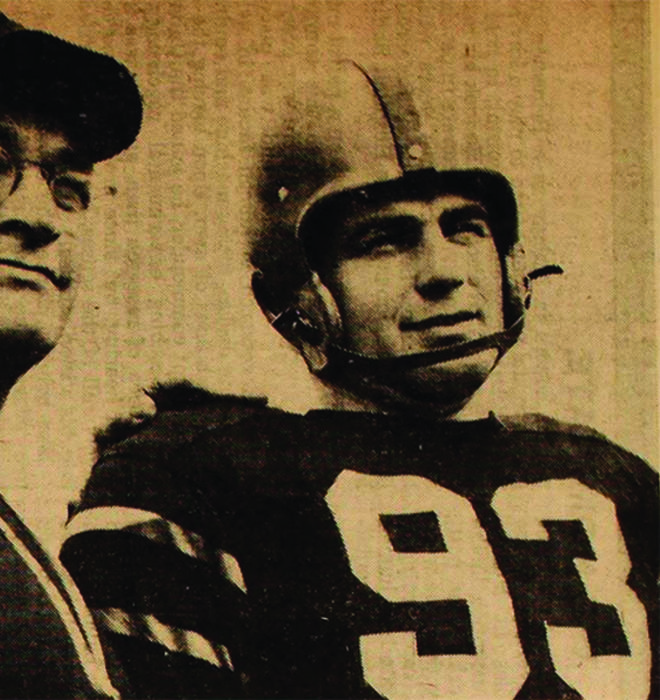
Sept. 29, 1928 — Jan. 25, 2022
On a January morning more than a year ago, George Sella ’50 delivered one final message to his family.
At 93 and battling health problems that left him confined to a downstairs den in his Newton, New Jersey, home, he was often wracked by pain and unable to speak since a 2013 stroke. But on this day, he expressed an undeniable feeling.
“That morning he put his thumb up — I feel good,” Janet Sella, his wife of 67 years, recalls. “And an hour later, he passed away. It was a shock, but it was good because he’s now in a better place.”
It was a fitting final sentiment for a full life that took form in Cliffside Park, New Jersey, where he met Janet, starred in football and basketball, and continued to Princeton, where his exploits further bloomed.
On the field, he was described by former coach Charlie Caldwell 1925 as “Mr. Princeton Football,” thanks to his broken-field running ability and two-way exploits as a defensive back. On the court, he was “Cyclone Sella,” a two-time All-Ivy League performer who averaged 11.6 points per game for the 1949 Tigers.
And outside the arenas, he was just as irrepressible.
Sella opted not to join the Chicago Bears of the NFL out of Princeton and instead furthered his study of science at Harvard Business School, graduating in 1952. He then launched a four-decade career with American Cyanamid, beginning as a chemical engineer and culminating as CEO of the manufacturing conglomerate.
Retiring in 1993 hardly slowed the Cyclone.
He continued as a consultant in his field and oversaw myriad real estate holdings. When the stroke in 2013 robbed him of his ability to speak, his granddaughter, Courtney Price, accompanied him to his office and served as Sella’s conduit, reading his “chicken scratch writing,” as she put it, and transcribing it into emails.
At 90, he was still driving to the office — and still feeding his neighborhood.
Sella’s moments of Zen came in his garden, where his tomato and strawberry yields were legendary. His broccoli, zucchini, squash — all of it would be distributed to neighbors.
“He was just such a hard, hard worker. Even just weeding the garden — he couldn’t stop until it was done,” remembers Price. “He had to complete everything he started.”
That certainly transferred to his professional life. Sella was loathe to vacation, but when the family did make a break for Long Beach Island on the Jersey shore, his briefcase always came with him, sometimes to the chagrin of his loved ones. He and Janet’s marriage was punctuated with laughter and eye rolls, poking fun, and exchanging knowing glances.
It was a model of family life for their five children, their 14 grandchildren, and 14 great-grandchildren, with more on the way.
Sella also never forgot his alma mater. He’d read a hard copy of PAW, flipping to the Memorials and hoping against hope none of his cohorts had died, tossing the issue aside in heartbreak if they had. And you could say the reputation he earned dutifully followed him to the end.
“He absolutely loved it there,” says Price. “They called him the Cyclone and we always said his office looked like a cyclone hit it, with the amount of papers he’d keep on his desk.
“We said, you carried the name on.”
Gabe Lacques is a sports journalist based in Northern Virginia.
This story was updated to correct the year of Sella’s final football season.






1 Response
Paul Hertelendy ’53
2 Years AgoTwo Sports Clarifications
This was the best issue ever, though admittedly I’ve only been reading PAW for 70 years. The featured dozen or so bios/obits were instructive and fascinating!
Two small corrections: In Lives Lived & Lost, George Sella ’50’s most beautiful moment was overcoming a greatly favored Dartmouth Indians side with his elegant zigzag through seemingly a dozen Hanover opponents with a late winning TD closing out the season — in 1949, not 1950. He even got an accolade voiced by the cleric in church (Alexander Hall) the next day.
Also, Robert Brawner ’52 (Memorials) swam butterfly, not breaststroke, in setting the first Princeton world record since the 1930s.
We senior seniors may not remember yesterday’s lunch, but we’re much better on events seven decades ago!
Keep up the good work.
Editor’s note: Brawner competed before the records for butterfly and breaststroke were officially split into two events, so his records remain in the breaststroke category.